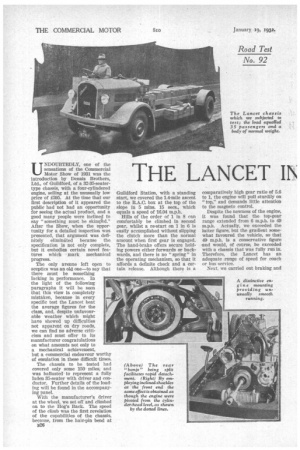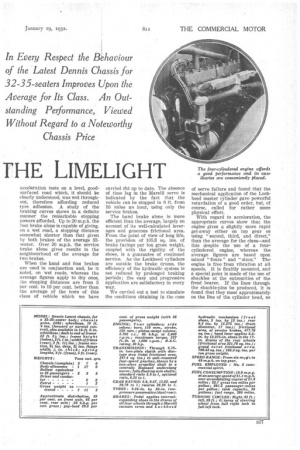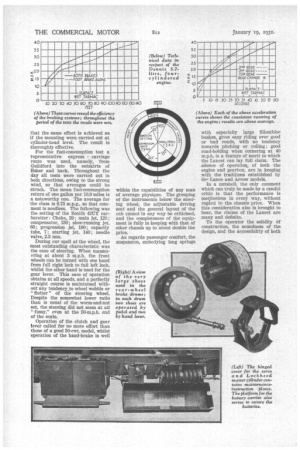THE LANCET IN
Page 44

Page 45

Page 46

Page 47

If you've noticed an error in this article please click here to report it so we can fix it.
THE LIMELIGHT UNDOTJBTEDLY, one of the sensations of the Commercial Motor Show of 1931 was the introduction by Dennis Brothers, Ltd., of Guildford, of a 32-35-seatertype chassis, with a four-cylindered engine, selling at the unusually low price of i595. At the time that our first description of it appeared the public had not had an opportunity for seeing the actual product, and a good many people were inclined to say "something must be skimpied." After the Show, when the opportunity for a detailed inspection was presented, that argument was definitely eliminated because the specification is not only complete, but it embodies certain novel features which mark mechanical p regress.
The only avenue left open to sceptics was an old one—to say that there must be something lacking in performance. In the light of the following paragraphs it will be seen that this view is completely mistaken, because in every specific test the Lancet beat the average figures for the class, and, despite unfavourable weather which might have showed up difficulties not apparent on dry roads, we can find no adverse criticism and must offer to its manufacturer congratulations on what amounts not only to a mechanical achievement, but a commercial endeavour worthy of emulation In these difficult times.
The chassis to be tested had covered only some 150 miles, and was ballasted to represent a fully laden 35-seater with driver and conductor. Further details of the loading will be found in the accompanying panel.
With the manufacturer's driver at the wheel, we set off and climbed on to the Hog's Back. The speed of the climb was the first revelation of the capabilities of the chassis because, from the hair-pin bend at B2t/ Guildford Station, with a standing start, we covered the 1.4-mile ascent to the R.A.C. box at the top of the slope in 5 mins. 15 secs., which equals a speed of 16.04 m.p.h.
Hills of the order of 1 in 8 can comfortably be climbed in second gear, whilst a re-start on 1 in 6 is easily accomplished without slipping the clutch more than the normal amount when first gear is engaged. The hand-brake offers secure holding powers either forwards or backwards, and there is no "spring" in the operating mechanism, so that it affords a definite check and a certain release. Although there is a comparatively high gear ratio of 5.6 to 1, the engine will pull sturdily on "top," and demands little attention to the magneto control.
Despite the newness of the engine, it was found that the top-gear range extended from 6 m.p.h. to 49 m.p.h. Actually, we exceeded the latter figure, but the gradient somewhat favoured the vehicle, so that 49 m.p.h. is a conservative figure and would, of course, be exceeded with a chassis that was fully run in. Therefore, the Lancet has an adequate range of speed for coach or bus service.
Next, we carried out braking and
acceleration tests on a level, goodsurfaced road which, it should be clearly understood, was wet throughout, therefore affording reduced lyre adhesion. A study of the braking curves shows in a definite manner the remarkable stopping powers afforded. Up to 20 m.p.h. the foot brake alone is capable of giving. on a wet road, a stopping distance somewhat shorter than that given by both brakes of the average 32seater. Over 20 m.p.h. the service brake alone gives results in the neighbourhood of the average for two brakes.
When the hand and fool brakes are used in conjunction and, be it noted, on wet roads, whereas the average figures apply to dry ones, :lie stopping distances are from 5 per cent. to 10 per cent, better than the average of the tests of this class of vehicle which we have carried out up to date. The absence of time lag in the Marelli servo is indicated by the fact that the vehicle can be stopped in 6 ft. from 10 miles an hour, using only the service brakes.
The hand brake alone is more efficient than the average, largely on account of its well-calculated leverages and generous frictional area. From the point of view of long life, the provision of 105.3 sq. ins, of brake facings per ton gross weight, coupled with the rigidity of the shoes, is a guarantee of continued service. As the Lockheed cylinders are outside the brake drums, the efficiency of the hydraulic system is not reduced by prolonged braking periods; the easy and progressive application are satisfactory in every way.
We carried out a test to simulate the conditions obtaining in the case of servo failure and found that the mechanical application of the Lockheed master cylinder gave powerful retardation of a good order, but, of course, called for rather more physical effort.
With regard to acceleration, the appropriate curves show that the engine gives a slightly more rapid get-away either on top gear on using "second, third, and direct," than the average for the class—and this despite the use of a four4 cylindered engine, whereas the average figures are based upon mixed "fours" and "sixes." The engine is free from vibration at all speeds. It is flexibly mounted, and a special point is made of the use of shackles at the extremities of the front bearer. If the lines through the shackle-pins be produced, it is found that they meet approximately. on the line of the cylinder head, so that the same effect is achieved as if the mounting were carried out at cylinder-head level. The result is thoroughly effective.
For the fuel-consumption test a representative express carriage route was used, namely, from Guildford into the outskirts of Esher and back. Throughout the day all tests were carried out in both directions, owing to the strong wind, so that averages could be struck. The mean fuel-consumption return of one gallon per 10.9 miles is a noteworthy one. The average for the class is 8.73 m.p.g., so that comment is needless. The following was the setting of the Zenith 42UY carburetter : Choke, 29; main jet, 120; compensator, 130; slow-running jet, 60; progression jet, 180; capacity tube, 7; starting jet, 140; needle valve, 2.5 mm.
During our spell at the wheel, the most outstanding characteristic was the ease of steering. When inanceuvring at about 3 m.p.h. the front wheels can be turned with one hand from full right lock to full left lock, whilst the other hand is used for the gear lever. This ease of operation obtains at all speeds, and a perfectly straight course is maintained without any tendency_to wheel wobble or " flutter " of the steering wheel. Despite the somewhat lower ratio than is usual of the worm-and-nut set, the steering did not seem at all "fussy," even at the 50-m.p.h. end of the scale.
Operation of the clutch and gear lever called for no more effort than those of a good 30-cwt. model, whilst operation of the hand-brake is well with especially large Silentbloc bushes, gives easy riding over good or bad roads, with no tendency towards pitching or rolling ; good road-holding when cornering at 40 m.p.h. is a feature of merit to which the Lancet can lay full claim. The silence of operation, of both the engine and gearbox, are in keeping with the traditions established by the. Lance and Arrow models.
In a nutshell, the only comment which can truly be made by a candid critic is that the performance is meritorious in every way, without regard to the chassis price. When this consideration also is brought to bear, the claims of the Lancet are many and definite.
To the operator the solidity of construction, the soundness of the design, and the accessibility of both major and minor components mean low maintenance charges. Depreciation must be, in consequence, at a reasonable rate, whilst tyre wear, thanks to the good suspension, should be slow. Fuel consumption, as has been made clear, is also better than the average, so that the running costs should be favourable. By reason of the low initial cost of the chassis, the allowance in the standing charges in respect of interest upon capital should be reduced as compared with conventional standards, thereby effecting a further economy.
We understand that this chassis has met with a ready sale since the Show. In view of our experience with it, this fact Is by no means surprising, and we can clearly see that the introduction of the Lancet marks a milestone in the history of one of Britain's foremost commercial-motor manufacturers.
From the point of view of the maintenance engineer the chassis design is perfectly straightforward and many of the components employed are of well-known Dennis types.
With the exception of the dynamo and starter, all the auxiliaries of the engine are on the near side. The dynamo and starter are easily reached from the inside of the cab after removal of quickly detachable cover plates, these being provided with handles.
For the gearbox a full-sized cover plate is provided, so that inspection or removal of selector forks, pinion assemblies, etc., is easily effected. The underslung worm-type rear axle is a proved Dennis product and its fully floating shafts permit removal of the differential without jacking up the axle. The accessibility of tha -components has obviously received
the designer's careful attention.




































































































